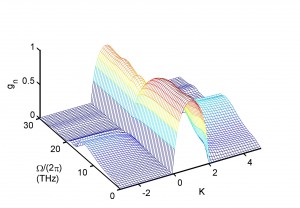Fiber optical parametric amplifiers utilise the Kerr nonlinearity of optical fibers. Careful dispersion control offers the possibility of ultra-broadband optical amplification. In a typical parametric amplifier a strong optical pump and signal (detuned from the pump by a frequency Ω) co-propagate in a fiber. If the phasematching at this detuning is correct the signal can experience strong parametric gain. As a consequence of the parametric interaction a copy of the signal (called the idler) is also generated at a detuning -Ω from the pump. Thus a parametric amplifier is capable not only of amplification, but also frequency conversion. To date the widest bandwidth CW optical amplifiers yet demonstrated are based on parametric amplification. Work at Auckland has focused mainly on the interaction of the Kerr and Raman nonlinearities and the consequences of this interplay on the gain flatness of optical parametric amplifiers.
A full model of the Raman effect requires the inclusion of both the real and imaginary parts of the Raman susceptibility as shown below:

Fig 1: Measured real and imaginary parts of the Raman susceptibility of a silica optical fiber (after Stolen et. al, J. Opt. Soc. Am. B 6, 1159-1166 (1989))
This allows us to derive an analytic expression for the combined Raman-parametric gain coefficient as a function of normalised phase-mismatch (K = – dk / 2γP ) and detuning. This curve is plotted in Fig. 2 and illustrates several key features of the combined interaction.
- At small detunings (Ω ≈ 0) the Raman effect has negligible influence on the parametric gain with the gain curve identical to that found in a pure Kerr medium with a peak parametric gain of 2γP at the normalised phase-mismatch of K = 1 (or dk + 2γP = 0).
- At large values of phase-mismatch |K |>>1 the gain curve reduces to the Raman gain curve set by the imaginary part of the Raman susceptibility only.
- At the phasematched detuning K =1 the combined Raman-parametric gain coefficient can be written as g = 2γP [1 – fR + fR*real(chi(3)_Raman (Ω))], where fR ≈ 0.18 is the fractional strength of the Raman susceptibility in silica. As a result the combined Raman-parametric gain depends on the real part the Raman susceptibility. This has important implications for the design of broadband parametric amplifiers with flat parametric gain. For example the strong dip in the real part of the Raman susceptibility seen at 15.5 THz in Fig. 1 results in a 40% reduction in the parametric gain available at this detuning.

Fig 2: Normalised Raman-parametric gain coefficient as a function of phase-mismatch and detuning.
We have experimentally measured the phasematched parametric gain of a single-pump fiber optical parametric amplifier as a function of detuning. This experiment was carried out in standard telecommunications dispersion-shifted fiber with a C-band quasi-CW pump. The measured phasematched parametric gain is shown in Fig.3 and clearly traces out the frequency dependence of the real part of the Raman susceptibility.

Fig 3: Experimentally measured phasematched gain of a single-pump fiber optical parametric amplifier as a function of seed detuning.
For more details on this work please see:
A. S. Y. Hsieh, G. K. L. Wong, S. G. Murdoch, S. Coen, F. Vanholsbeeck, R. Leonhardt, and J. D. Harvey, “Combined effect of Raman and parametric gain on single-pump parametric amplifiers,” Opt. Express 15, 8104-8114 (2007)
J. C. C. Wang, S. G. Murdoch, R. Leonhardt, and J. D. Harvey, “Strong signal suppression in single-pump optical parametric amplifiers”, Optics Letters 33 935-937 (2008)
Y. Q. Xu, S. G. Murdoch, R. Leonhardt, and J. D. Harvey, “Raman-assisted continuous-wave tunable all-fiber optical parametric oscillator,” J. Opt. Soc. Am. B 26, 1351-1356 (2009)